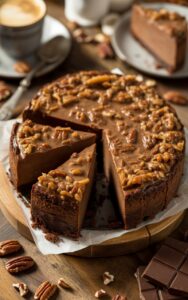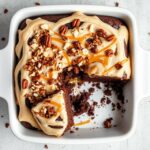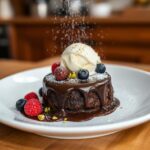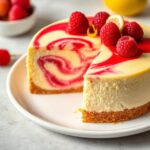There are desserts that catch your eye, and then there are desserts that stop you in your tracks. German Chocolate Cheesecake belongs to the second category. Every time I make it, I find myself pausing for just a moment before serving, simply to appreciate the way it looks—rich, layered, and indulgent. This is not just any cheesecake; it is the kind of dessert that makes people close their eyes after the first bite.
What makes this cheesecake so special is its marriage of two classics: the creamy, velvety cheesecake and the iconic German Chocolate Cake. On its own, cheesecake is already luxurious. Add to that the chocolate base, the coconut-pecan topping, and the smooth layers of sweetness, and suddenly, you have a dessert that speaks to both comfort and elegance.
When I create a cheesecake like this, my intention is to bring together flavor, texture, and visual appeal in every slice. The soft richness of the chocolate filling, the crunch of the crust, and the chewy-sweet topping make this recipe stand out in the world of desserts. For me, it is one of those creations that remind me why I fell in love with baking in the first place.
What is German Chocolate Cheesecake?
German Chocolate Cheesecake is a luscious twist on the famous German Chocolate Cake. At its heart, it is still a cheesecake—smooth, creamy, and baked with care—but it borrows the deep chocolate flavor and the iconic topping of the original cake. Instead of being layered with chocolate sponge, this cheesecake is built on a base of rich chocolate filling and topped with a generous crown of coconut and pecans.
What sets it apart from other chocolate cheesecakes is that topping. The coconut-pecan layer is cooked gently on the stove until it becomes sweet, gooey, and nutty, then spooned generously over the chilled cheesecake. That one addition changes the experience completely. Each bite becomes layered with creaminess, crunch, and caramel-like sweetness that you won’t find in a standard chocolate cheesecake.
It’s a dessert that feels indulgent yet surprisingly approachable. While some cheesecakes can be overly heavy, this one has balance. The chocolate gives it depth, the cream cheese lends it richness, and the topping adds lightness and texture. If you ask me, it is one of the most memorable cheesecakes you can bring to a table.
Why You’ll Love This Recipe
Every recipe I share comes from years of experience testing, tasting, and improving, and I can say with confidence that this German Chocolate Cheesecake is one of the most rewarding desserts to bake at home. There are several reasons why I keep returning to this recipe.
First, the flavor profile is irresistible. The chocolate base has that smooth, deep cocoa taste, but it isn’t overpowering. The cream cheese filling is perfectly balanced with just enough sweetness, and then the topping brings everything together with nutty richness. If you love desserts that offer contrast in every bite, this is the cheesecake for you.
Second, it is a showstopper. When you place this cheesecake on the table, it naturally becomes the centerpiece. Guests can’t help but lean in and admire the glossy chocolate, the golden coconut, and the studded pecans. It’s the kind of dessert that makes people ask, “Did you really make this yourself?”—and nothing feels better than answering yes.
Finally, this recipe is versatile. While I prefer baking it in its classic round cheesecake form, you can also adapt it into bars, mini cheesecakes, or even a no-bake version if you’re looking for something simpler. I’ve experimented with each style, and the flavors hold up beautifully in every version. That flexibility makes it a great recipe to keep in your collection.
A Little History of German Chocolate Cake
To appreciate German Chocolate Cheesecake, it helps to know where its inspiration comes from. Many people assume that German Chocolate Cake originated in Germany, but the truth is that it was created in the United States. The cake was named after Samuel German, an American baker who developed a type of sweet baking chocolate for the Baker’s Chocolate Company in the mid-1800s. The chocolate was milder than dark chocolate, with a balanced sweetness that made it ideal for cakes and desserts.
The recipe for German Chocolate Cake, as we know it today, first appeared in the 1950s. A Texas homemaker submitted it to a local newspaper, and it quickly spread across the country. What made it stand out was the signature coconut-pecan frosting. Unlike most cake frostings, this one wasn’t whipped or butter-based. Instead, it was cooked gently until it became rich, sticky, and filled with texture. That topping gave the cake its personality and turned it into an American classic.
Cheesecake bakers, myself included, saw the potential in combining that famous cake with the creamy texture of cheesecake. The idea was simple but brilliant: take the essence of German Chocolate Cake and reimagine it as a cheesecake. The result is exactly what we enjoy today—German Chocolate Cheesecake, a dessert that brings history, creativity, and pure indulgence together in one bite.
Key Ingredients Explained
Every successful dessert begins with the right ingredients, and German Chocolate Cheesecake is no exception. Over the years, I’ve learned that choosing the right quality for each component can elevate your cheesecake from good to unforgettable.
The first essential ingredient is cream cheese. I always recommend using full-fat cream cheese because it gives the cheesecake that smooth, creamy texture that feels luxurious on the tongue. Reduced-fat versions may seem tempting, but they simply don’t provide the same richness, and they can cause the filling to turn out softer than desired.
Chocolate is, of course, the star of the show. Traditionally, German sweet chocolate was used in the cake, but for cheesecake, I find that semisweet or dark chocolate provides better depth and balance. The key is to use a good-quality chocolate bar rather than chocolate chips, as bars melt more smoothly and create a richer consistency.
The crust is often underestimated, but it sets the foundation for the entire dessert. A chocolate cookie crust works beautifully here, as it complements the chocolate filling without overpowering it. I usually use chocolate wafer cookies or chocolate graham crackers, crushed finely and mixed with melted butter to bind them together.
Then comes the topping—the iconic coconut-pecan layer. Sweetened shredded coconut and chopped pecans are non-negotiable, but the secret lies in how they are combined. By simmering them with butter, sugar, and evaporated milk, you create a topping that is sticky, nutty, and almost caramel-like in flavor. It’s this element that truly defines German Chocolate Cheesecake and sets it apart from other chocolate desserts.
Essential Equipment You’ll Need
While ingredients provide the flavor, the right tools make the process smoother and more reliable. One tool I never skip when baking cheesecake is a springform pan. Its removable sides allow you to release the cheesecake without disturbing its shape, giving you clean edges and a beautiful presentation.
A water bath is another must-have technique for baking cheesecake. To prepare one, you’ll need a larger roasting pan where you can place the springform pan and surround it with hot water. This method ensures even baking and helps prevent cracks on the surface of your cheesecake. I’ve tried skipping it in the past, but the difference in texture is undeniable—cheesecakes baked in a water bath are silkier and more luxurious.
A good-quality electric mixer, either stand or handheld, is also essential. Cheesecake batter should be mixed until just smooth, without overbeating, which can incorporate too much air and cause cracks. A mixer allows you to achieve the right balance without overworking the batter.
Lastly, don’t overlook the basics—mixing bowls, a sturdy whisk, a rubber spatula, and parchment paper. These small details can make the process less stressful and more enjoyable, especially if you plan to bake this cheesecake more than once, which I suspect you will.
Step-by-Step Recipe Instructions
When I bake German Chocolate Cheesecake, I like to think of it as a series of manageable steps rather than one big project. Breaking it down makes the process not only easier but also more enjoyable.
I always begin with the crust. Crush the cookies into fine crumbs and mix them with melted butter until the mixture resembles wet sand. Press this firmly into the bottom of the springform pan, making sure it is even and compact. I bake the crust for a few minutes before adding the filling, as this helps it set and prevents it from becoming soggy later.
Next comes the cheesecake filling. Melt the chocolate gently, either in a heatproof bowl set over simmering water or in short bursts in the microwave, stirring frequently. Once smooth, set it aside to cool slightly. In a large bowl, beat the cream cheese until smooth, then add sugar and a touch of vanilla extract. Mix in the eggs one at a time, ensuring each is fully incorporated before adding the next. Finally, fold in the melted chocolate until the batter is smooth and glossy.
Pour the filling over the cooled crust and smooth out the top with a spatula. At this stage, I prepare the water bath. Wrap the bottom of the springform pan in foil to prevent leaks, place it in the roasting pan, and pour hot water into the pan until it reaches about halfway up the sides of the springform. Bake until the cheesecake is set at the edges but slightly wobbly in the center. This is the secret to a creamy texture once it cools.
When baking is complete, turn off the oven and leave the cheesecake inside with the door slightly open for about an hour. This gentle cooling helps prevent cracks. After that, transfer it to the refrigerator and let it chill completely—at least four hours, but ideally overnight. Patience is key here; the flavors deepen as it rests.
How to Make the Coconut-Pecan Topping
The topping is what transforms this cheesecake into something unforgettable. It’s rich, nutty, and slightly chewy, creating a contrast that complements the creamy filling beautifully.
To prepare it, I start by melting butter in a saucepan over medium heat. Once melted, I stir in sugar and evaporated milk, cooking the mixture slowly until it thickens slightly. This process requires a bit of patience, but the reward is a topping with the perfect consistency.
Once the mixture has thickened, I stir in egg yolks, whisking constantly to ensure they cook evenly without scrambling. The mixture becomes glossy and smooth as it cooks. At this point, I remove it from the heat and fold in the shredded coconut and chopped pecans. The heat softens the coconut and releases the oils in the pecans, intensifying their flavor.
After allowing the topping to cool slightly, I spread it generously over the chilled cheesecake. The sticky coconut, crunchy pecans, and buttery caramel-like base form a crown that makes every slice irresistible. It’s the finishing touch that elevates this cheesecake into a dessert worth remembering.
Assembly and Final Touches
Bringing the elements together is one of my favorite parts of making German Chocolate Cheesecake. Once the cheesecake has fully chilled and the topping is ready, the assembly process transforms it from a simple baked dessert into a true showpiece.
I begin by carefully releasing the cheesecake from the springform pan. Running a thin knife along the edge before unlocking the pan helps prevent sticking. Once freed, I transfer the cheesecake onto a serving plate or cake stand for presentation.
The topping, by this point, should be cooled but still spreadable. I spoon it over the cheesecake, spreading it evenly across the surface. I prefer leaving the edges slightly rustic, allowing bits of pecan and coconut to cascade naturally over the sides. This not only enhances the visual appeal but also gives guests a preview of the flavors in every slice.
For an extra flourish, I sometimes drizzle melted chocolate across the topping or scatter a few whole pecans on top. These small touches elevate the dessert visually and make it feel special, almost as though it came from a high-end bakery.
Pro Tips for the Perfect German Chocolate Cheesecake
With years of baking experience, I’ve gathered a few tricks that guarantee cheesecake success every time.
One of the most important is patience. Cheesecake benefits from slow mixing, slow baking, and slow cooling. Rushing any of these steps can compromise the texture. For example, overbeating the batter introduces too much air, which leads to cracks. Likewise, skipping the resting period in the oven often results in a sunken center.
Temperature control is another crucial factor. Ingredients like cream cheese and eggs should always be at room temperature before mixing. Cold ingredients don’t blend smoothly, leading to lumps in the batter. Similarly, baking the cheesecake at a moderate, steady heat prevents the filling from curdling or becoming grainy.
Lastly, always give your cheesecake ample time to chill. Overnight refrigeration may test your patience, but it allows the flavors to meld and the texture to firm up perfectly. In my kitchen, I consider it non-negotiable.
Variations You Can Try
While I love the classic version of German Chocolate Cheesecake, there are countless ways to adapt it for different occasions. Mini cheesecakes baked in muffin tins, for instance, are perfect for parties where guests prefer individual servings. These bake faster and require less chilling time, making them a convenient option.
Another variation I enjoy is the no-bake version. Instead of baking the filling, I whip cream cheese with melted chocolate and fold in whipped cream for a lighter texture. The coconut-pecan topping remains the same, giving you the signature flavor without turning on the oven.
For those who prefer something a bit less rich, try turning the recipe into cheesecake bars. These are made in a square pan and cut into small squares, which are easier to serve at gatherings. The balance of crust, filling, and topping still shines through in every bite.
Common Mistakes to Avoid
Even the most experienced bakers can run into trouble with cheesecake, but knowing the pitfalls makes it easier to avoid them.
One common mistake is skipping the water bath. While it may seem like an extra step, it ensures even baking and prevents cracking. If water leakage worries you, double-wrap the pan with foil or use a silicone water bath wrap for added protection.
Another mistake is overbaking. Cheesecake should look slightly wobbly in the center when you remove it from the oven. Many assume it’s underbaked at this stage, but it will continue to set as it cools. Overbaking results in a dense, dry texture that lacks the creaminess of a perfect cheesecake.
Finally, resist the urge to cut into the cheesecake too soon. Slicing before it has chilled fully will cause the layers to collapse and the topping to slide off. Waiting is not easy, but it’s always worth it.
Serving Suggestions and Pairings
German Chocolate Cheesecake is indulgent enough to stand on its own, but thoughtful pairings can enhance the experience. A strong cup of coffee or espresso balances the sweetness and highlights the chocolate flavor. If you prefer tea, a roasted variety like oolong or black tea works beautifully.
For a more festive presentation, I sometimes serve it with lightly sweetened whipped cream or a drizzle of chocolate ganache on the plate. Fresh berries, especially raspberries or strawberries, add a refreshing tartness that cuts through the richness.
If you’re hosting a dinner, consider pairing it with dessert wines such as port or a late-harvest Riesling. Their natural sweetness harmonizes with the cheesecake without overwhelming it.
How to Store and Freeze Cheesecake Properly
Storage plays a huge role in maintaining the quality of your cheesecake. Once topped, I store mine in an airtight container in the refrigerator, where it stays fresh for about five days. If you prefer, you can store the topping separately and add it just before serving to keep the textures distinct.
For longer storage, cheesecake freezes surprisingly well. To freeze, wrap the cooled, un-topped cheesecake tightly in plastic wrap, followed by aluminum foil. It can be stored in the freezer for up to two months. When you’re ready to serve, thaw it overnight in the refrigerator and then add the topping fresh. This method preserves both flavor and texture.
Make-Ahead Instructions
One of the best things about cheesecake is that it’s naturally suited for making ahead. In fact, I recommend preparing it at least a day in advance for the best flavor. The topping can also be made a day early and stored in the refrigerator. Simply reheat it gently to loosen before spreading it over the cheesecake.
If you’re preparing for a large event, you can bake the cheesecake several days in advance and freeze it. Having this option reduces stress and allows you to focus on other dishes without sacrificing dessert quality.
FAQ Section
Can I make this recipe without a water bath?
Yes, but I don’t recommend it. A water bath ensures even baking and prevents cracks. If you prefer to skip it, consider using a lower oven temperature and placing a pan of water on the rack below.
What can I use instead of pecans?
Walnuts are a great alternative and provide a similar texture. Almonds also work, though they add a different flavor profile.
Can I make this gluten-free?
Absolutely. Use gluten-free chocolate cookies for the crust, and ensure your chocolate and other ingredients are certified gluten-free. The rest of the recipe remains the same.
How long should the cheesecake chill?
At least four hours, but overnight is ideal for the best texture and flavor.
Healthier Ingredient Swaps
If you’d like to enjoy German Chocolate Cheesecake with fewer calories, there are a few adjustments you can make. Greek yogurt can replace part of the cream cheese, reducing fat while maintaining creaminess. Coconut sugar or maple syrup can substitute for granulated sugar, giving the dessert a natural sweetness.
For the crust, almond flour combined with a bit of cocoa powder and butter makes a lower-carb alternative to cookie crumbs. These swaps don’t compromise flavor too much, but they do lighten the overall dessert for those seeking balance.
My Personal Experience Making This Cheesecake
Every time I bake this cheesecake, I’m reminded of why I love combining tradition with creativity. The first time I made it, I was nervous about whether the coconut-pecan topping would overpower the cheesecake, but instead, it elevated it. Friends and family who tasted it couldn’t stop at one slice, and that reaction alone told me the recipe was a keeper.
Over time, I’ve perfected the method—learning when to stop mixing, how long to bake, and how to achieve the perfect topping consistency. Today, it’s one of my signature desserts, and I take pride in serving it whenever I want to impress guests or mark a special occasion.
Conclusion
German Chocolate Cheesecake is more than just a dessert; it’s a masterpiece of flavor and texture. From the silky chocolate filling to the decadent coconut-pecan topping, every bite offers something memorable. With the right ingredients, patience, and a few expert tips, you can create a cheesecake that rivals anything you’d find in a bakery.
If you’ve never baked this dessert before, I encourage you to try it. It may take a bit of time and care, but the reward is a showstopping cheesecake that’s as enjoyable to make as it is to eat. For me, it remains one of the most satisfying recipes I’ve ever mastered, and I know it will become a favorite in your kitchen too.




